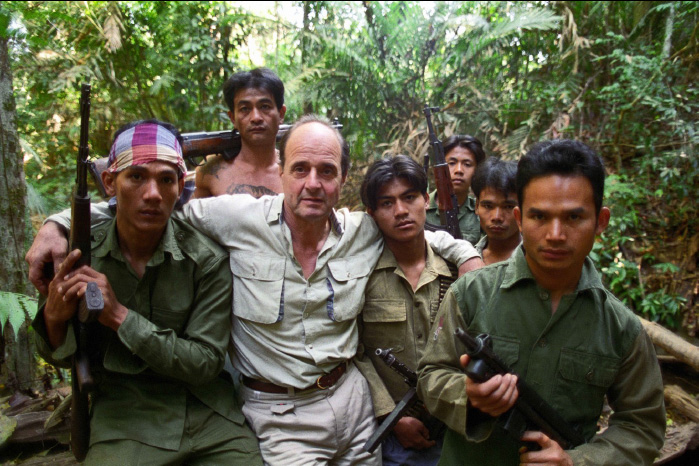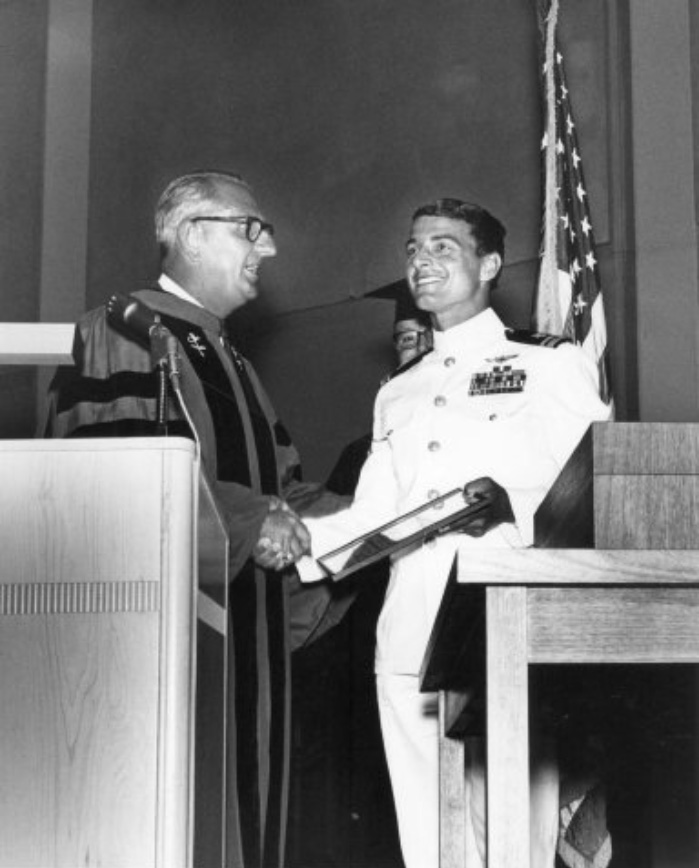Dieter Dengler (CSM Class of 1963)
U.S. naval aviator
First and longest-held Vietnam War POW to escape from captivity
Awarded the Navy Cross for his odds-defying escape
CSM Aeronautics Student of the Semester, 1962
Dieter Dengler first dreamed of flight as a boy in World War II Germany when a low-flying Allied bomber lay waste to his Black Forest town. So close he could see the pilot’s face, Dengler instantly equated flight to freedom, to escape from the hunger the war had visited on his family.
The Laotian official who sent him to prison decades later pointed out the irony: “The Americans did this to your family, and yet you just about lost your life for your country.”
Dengler (1938-2001) replied, “When I entered the Navy there was no war in sight. Now there is, and I am obligated to it.”
Dengler’s escape from that POW camp became one of the Vietnam War’s most celebrated stories. Shot down over Laos in June 1966 and quickly captured, Dengler escaped and was retaken before breaking out six months later.
Surviving on snakes and insects, he hiked 23 days in the jungle before flagging down a U.S. plane with a scrap of stolen parachute. He lived longer in captivity before escaping than any other American in the Vietnam War. Christian Bale plays him in the 2006 film Rescue Dawn.
College of San Mateo played a key role in Dengler’s story. While Dengler honed his survival skills in brutally poor postwar Germany, he began flight training at CSM. Starting in the 1930s, CSM was one of few places in California where anyone could go to ground school for free. San Mateo Junior College, as it was then known, launched its aeronautics program during the Depression to supply engineers, technicians and crew to the new San Francisco International Airport.
Dengler left Germany in 1957, joining his younger brother Martin in San Francisco, then enlisting in the U.S. Air Force. He served four years without aviation training, learning too late that it was reserved for college graduates.
So Dengler enrolled at CSM. He was still desperately poor, living in a Volkswagen van that he kept running with parts he appropriated in the dead of night from other vehicles on the street. But he was tall, handsome and charismatic, and he studied hard, becoming Aeronautics Student of the Semester in 1962 and graduating in January 1963. He passed the Navy’s aviation cadet exam soon after.


His Navy legend was born in the Survival Escape and Evasion (SERE) course in San Diego. Dengler became the first ensign in the exercise’s history to escape capture, once holding a clandestinely sharpened pipe to an instructor’s throat. He also became the only person to gain weight during the exercise, which he managed by eating instructors’ garbage. More crucially for his later ordeal, Dengler eagerly sampled the insects, grubs and rats that his trainers advised were good sources of protein. As a POW, Dengler fought snakes for the rats they would catch.
His unit, VA-145, sailed to the South China Sea aboard the USS Ranger. Dengler was flying a clandestine mission into Laos on Feb. 2, 1966 when his single-engine Douglas A-1 Skyraider, or “Spad,” was shot down. Though Laos was officially neutral, large chunks were held by the communist Pathet Lao helping supply the Viet Cong over the Ho Chi Minh Trail. It was Pathet Lao guerrillas who seized Dengler soon after he stumbled nearly unhurt from his Spad’s crash landing.
True to his Navy SERE training, Dengler escaped the Pathet Lao within days. They recaptured him 18 hours later, having tracked him to water. Dengler realized, he later said, that the jungle itself was his prison. If he were ever to see America, he would have to summon help from the air.
Refusing to sign a fake confession, Dengler was thrown into a POW camp with other Americans and tortured. As months passed, they devised a plan to escape by overpowering their guards at mealtime, then signaling for U.S. air support. Dengler would be the only American to survive this attempt.
The plan derailed and the Americans were forced to shoot several guards. They had not wanted to, because this ended any protection they might have under the Geneva Conventions for war captives. It also meant they had to flee into the jungle.
Dengler’s buddy was beheaded by a pursuing enemy with a machete. Dengler was near death from malnutrition when a Spad on patrol happened to catch his signaling on July 20, 1966, more than six months after he went MIA. The helicopter crew that brought Dengler up—starving, semi-conscious, rife with diseases—feared he was Viet Cong until a half-eaten snake emerged from his backpack.
On his return to the Ranger, one of the first things a squadron mate asked was, "What took you so long, man?” said his crewmate and future biographer Bruce Henderson.
Dengler was hospitalized for weeks while he regained the 59 pounds he had lost in captivity. Defying his doctors, he eloped to Reno with his fiancé, CSM classmate Marina Adamich. They opened a German restaurant on Mount Tamalpais “so I will never again be hungry,” Dengler told reporters. He stored thousands of pounds of flour and butter in hidden chambers that he obsessively patrols in Little Dieter Needs to Fly, one of two movies, along with Rescue Dawn, that German director Werner Herzog made about his life.
Dengler returned to the air as a flight engineer with TWA. His marriage to Adamich lasted four years. Dengler remarried and, according to friends, was happy.
“Anyone who met Dieter and spent any time with him never forgot him,” Henderson said. “Larger than life? Yes. Fully engaged in life and trying to wring the last drop out of it? You bet.
“Dieter relaxed by having fun, although the ways he had fun some of us might not consider very relaxing. Flying loops and spins in his restored biplane; racing down the steepest ski slopes, traveling the world with nothing more than a backpack and an itch to see more places. ...Those who knew him were not surprised by his escape because, well, Dieter could do just about anything he set his mind to do.”
In 1999, Dengler was diagnosed with rapid-onset Parkinson’s disease. On Feb. 7, 2001, 35 years after his capture in Southeast Asia, he took his own life. He is buried in Arlington National Cemetery.
Watch video of Dengler’s September 1966 post-rescue news conference.
Watch Little Dieter Needs to Flyon YouTube.
Learn about Dengler’s 2010 biography, Hero Found: The Greatest POW Escape of the Vietnam War.

